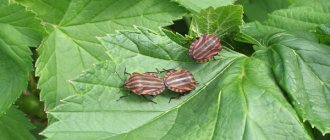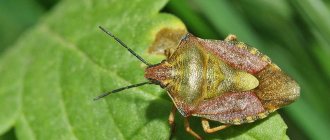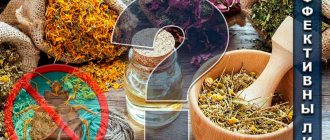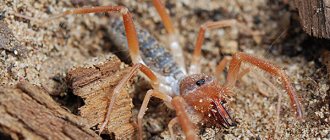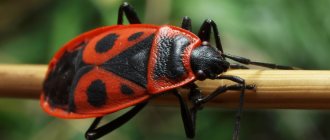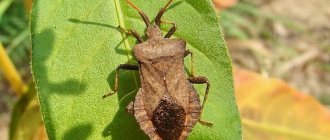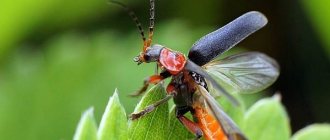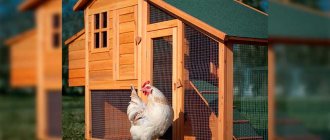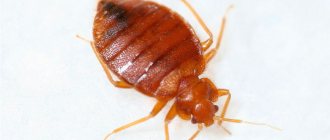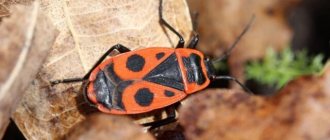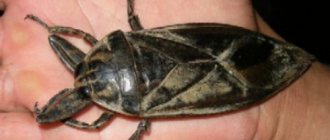The stink bug is a very common insect. They have a chitinous shell, shaped like a shield, for which they are called shield bugs. The shell protects the bug from the external environment.
The bug lives near bodies of water and feeds on the juice of plants, berries, cereals and the remains of other insects.
The stink bug is known for its unpleasant odor due to a substance secreted by the scent glands in case of danger.
But this property of the insect is also used for the benefit of people. A method of treating alcoholism using vodka tincture on wood bugs has long been known. This article will tell you what types of stink bugs there are, how to recognize this insect, what harm it can cause to the crop and how to fight the pest.
REPRODUCTION
Shield bugs usually breed in the summer. When pairs form in these insects, smell plays an important role. Individuals of different sexes use it to find and recognize each other. Many species do this using sounds reminiscent of the chirping of a cricket, which are formed as a result of friction of the hind legs. Before fertilizing the female, the male shield bug performs a kind of “overture,” during which he circles around the female and gently touches her body with his head.
The male “sings” and moves his antennae. During mating, the genital organs of insects are firmly connected, and their heads are directed in opposite directions. They often remain in this position for several hours. The females then lay eggs. Herbivorous species look for special plants for these purposes, while predatory species are less picky in this regard - their testicles can be found on the inside of leaves or around plant stems. The female shield guards the testicles. If anyone disturbs her, she covers them with her body like a shield. The hatched larvae hide under the female, who continues to take care of them. Shield insect larvae are small, wingless miniatures of their parents. Their color resembles that of an adult. The larvae molt four times. After the fifth molt, they already become adult insects.
Life cycle of an insect.
In winter, these bugs hibernate, choosing dry, warm places for this. Fallen leaves, stumps, old trees, and under stones are suitable for this. When spring comes, insects emerge from suspended animation and begin to actively eat. If, upon awakening, there is not enough food for them in the forests or fields, then the bugs can fly into vegetable gardens, orchards, and agricultural land. This is why bugs can also be found inside residential premises.
Having woken up, the bugs look for food and a place to reproduce. When it gets very warm, and there are a lot of plants around, female bugs lay eggs on the back of the leaves. This is done twice during the summer. One oviposition can contain up to 100 eggs. They look like small green balls, at the end of which there are peculiar caps to make it easier for the larvae to get out.
The larvae are very similar to the adults, only smaller and without wings. During the entire development process, they molt several times. Due to the fact that chitinous shells are very hard and tough, some bugs cannot get out and die.
WHAT DOES IT EAT?
The diet of these bugs is quite rich and varied. Shield insects live on herbaceous plants, shrubs, and trees, so many species of these insects suck juices from plants and seeds, into which they first inject digestive juice. Special bacteria found in their digestive tract help digest food. Females wipe the testicles with the contents of the digestive tract, which contains cultures of these bacteria, in order to transfer them to the larvae, which hatch. Most stink bugs will catch any prey they can lay their hands on. They even hunt those abandoned by other predators.
Struggle
How to fight:
- Garlic is effective in pest control. A glass of chopped garlic is poured with water in a liter jar and sealed tightly. Infuse for five days and filter. For a bucket of water you need two glasses of garlic tincture. Plants are sprayed with this solution
- Monitor the condition of the soil in the greenhouse. Because crops become infected through it. To improve the microflora, use nettle tincture. The nettle must be filled with water and kept for seven days in a warm place. The fermented solution is used to treat the soil in greenhouses.
Stink bug in the apartment:
PROTECTION AGAINST NATURAL ENEMIES
Shieldbirds live in constant danger - they can always become victims of birds. Therefore, most species that are at risk have reliable protective devices. If these are insects that feed on plant juices, then their shields will usually be green, and those species that live on the bark of trees, as a rule, have a gray or brown color. Many species that eat plants taste very bad or contain poisonous substances, in which case other animals do not eat them.
How harmful is the parasite?
Some insects negatively affect the plants they live on. The representative eats leaves and fruits, leaving behind brown marks. When stink bugs invade, the entire crop can be destroyed. Favorite treat: raspberries.
Bed bugs love raspberries
The insect leaves an unpleasant odor from the glands on the berries and leaves. With a lack of glands, the insect switches to agricultural crops, namely cereals. Often a representative lives in an apartment.
When an insect enters an apartment, it does not harm residents. The only negative is the unpleasant aroma from the parasite.
LOCATION
Shield insects inhabit very different regions - from mountains to tropical mangrove swamps. Many species of these insects live in deserts. Shield insects living in the tropical zone are the most brightly colored among all other species. There are approximately 60 species of bedbugs living in Europe, most of which are unremarkable in appearance. In addition to stink bugs, there are families of bugs such as bed bugs, which suck the blood of vertebrates and even humans. In Europe, a “domestic predator” is widespread, which exterminates flies in houses.
Reasons for appearance
For a long time there was an opinion that dangerous insects only appear where there is dirt and poverty.
In recent years, the situation has changed: parasites often appear in the homes of wealthy people, where they are clean, rich and comfortable. The reason is multiple ways pests can enter your home.
It is important to know what points to pay attention to so as not to accidentally bring biting insects home. .
Unpleasant “neighbors” appear in your home in different ways:
- with new furniture purchased in the salon. If harmful insects lived in the furniture sales center, they will calmly “move” to new owners,
- crawl from other apartments through chokes, enter open windows,
- along with purchased antiques. Antique books, paintings, furniture are a good refuge for biting insects,
- when buying clothes at a flea market. Sometimes parasites remain in worn things, the new owner of a blouse or sweater learns about the existence of “neighbors” only by painful bites,
- after the trip. If there were bedbugs in an inexpensive hotel, there is a high risk of bringing the parasites home among your belongings.
SHIELD BIRD OBSERVATIONS
Shield insects can be observed throughout the year, at any time. In early spring, red stink bug is often found on plants. He is the owner of a red-brown color. This is one of the first insects that heralds spring. In summer, while picking wild berries, you can see the berry bug. Autumn is the best time to observe stink bugs, as most species of these insects are often the last insects to be found in the wild before winter sets in.
Effective methods of control
How to remove bedbugs from their apartment? If dangerous insects are identified, their destruction must begin immediately. The longer bedbugs live in a house, the more actively they multiply and invade new areas. If there is an invasion of parasites, you cannot do without calling an exterminator. If there are still few insects, you can cope without the help of a specialist after studying the recommendations for pest control.
The following methods are suitable for exterminating dangerous insects:
- treating the premises with chemicals,
- use of traditional methods,
- total disinsection by specialists of the sanitary and epidemiological service.
INTERESTING FACTS. DID YOU KNOW THAT...
- There is one species of shieldfish that has adapted to life in the Arctic ice.
- The female takes care of the offspring for many weeks; when the larvae become adults, they die.
- Many species of stink bugs, in case of danger, immediately release a specific liquid with a pungent “bedbug” odor, which is why they are called “stinking bugs.”
- Shield insects carefully take care of egg laying - they pay much more attention to them than other insects, except, of course, bees, wasps and ants.
Why does the forest bug smell like that?
When in danger, an insect emits a very characteristic and unpleasant odor, which explains its popular name - “stink bug”. On the back of its cephalothorax there are special glands that produce a secretion that contains cimycin acid, which gives the bug its smell. In addition, this secretion is poisonous to other insects, but it is harmless to humans.
It is assumed that the specific smell serves not only to scare off possible rivals in the fight for a female or nutrient medium, but also to attract a partner.
When the “stinker” settles in the raspberries, it is capable of rendering the berries unusable with its smell, spoiling their taste and aroma.
Green bugs are not a scourge that requires the use of chemicals; usually it is enough to simply collect and destroy the insects you notice
CHARACTERISTICS
Shield insects have a movable proboscis, with which they pierce the integument of the body of an animal or plant and suck out blood or cell sap. In some species, the proboscis is located at the bottom of the body.
Two pairs of wings, the first of which are typical semi-rigid elytra.
— Habitat of shieldbills
WHERE DOES IT LIVE?
All over the world, in almost all climate zones. Most species live in the tropics.
PROTECTION AND PRESERVATION
Most species are not in danger of extinction. Some species are considered pests in certain regions, such as the stink bug, which attacks wheat fields in Europe, parts of Asia and the Middle East.
Disinsection instructions
You should always remember that potent agents are used only in cases of increased insect activity, when your home is literally “taken over.”
Before disinfection, the first thing you need to do is prepare the room:
- remove bed linen, covers from furniture, soak all clothes from the wardrobe for a day and wash,
- create free access to all places, objects,
- During the disinfection, remove all pets from the premises, and after returning, be sure to bathe them with special shampoos,
- take out unnecessary things (dishes, books).
Next, you need to decide what means of destruction will be used. You can take folk recipes, for example, spraying cedar oil, kerosene, dust or chemicals (Sinuzan, Sychlor, Karbofos, Permethrin). You can also use dichlorvos "Antiklop" at home. Recently, safe and effective drugs have gained popularity: Minap 22, Xulat C25.
In order to process the premises, protective equipment is required
After the procedure, it is important to thoroughly ventilate everything and wipe the surfaces with a soda solution.
It is very undesirable to carry out actions to combat bedbugs yourself. If you need excellent results without causing damage to your own health, you should seek help from professionals who have modern equipment, high-quality drugs and extensive experience behind them. But in any case, if you want to do everything yourself, strictly follow the sanitary and epidemiological rules of Pest Control.
Red-black striped stink bug or striped graphozoma. Video (00:00:55)
This bright bug is hard to miss, because its body is covered with contrasting black and red stripes. They gave him all sorts of names for this: tiger bug, striped bug, Italian bug. But in scientific terms it is called lined shield or striped graphozoma, and in Latin, then Graphosoma lineatum. It would seem that what is Italian about this bug? Quite an ordinary domestic bug. The fact is that its coloring is somewhat reminiscent of the colors of the ceremonial uniform of the Vatican Guards - the famous Swiss Guard, the guards of the Pope. This bug has all the characteristics that make it a member of the shield bug family: first of all, this is, of course, the scutellum - a durable chitinous plate of the mesothorax, shaped really like a shield. And it performs the same function - it protects the vulnerable parts of the bug’s body (abdomen, wings, internal organs) like the shell of a turtle. A triangular head and 6 black stripes on a red background, as well as black spots on the underside of the abdomen are also distinctive features of this bug. It is not for nothing that people use such coloring as a warning of danger; this technique is borrowed from nature. Unlike other bugs that try to hide against the background of leaves, graphozoma, on the contrary, tries to be as noticeable as possible. It seems that such behavior should be dangerous for the life of the bug? But it is poisonous and warns all birds and insects about it in advance. It turns out that you can be safe not by hiding, but by deliberately exposing yourself. If this is not enough, the bug has another remedy - odorous discharge with a very unpleasant odor. Like all bugs, the scale insect has a sucking mouthpart in the form of a proboscis, with which it pierces and drinks plant juices. This type of bug prefers umbrella plants. It can often be found on dill seeds, it does not ignore parsley, carrots, and is often found on the ubiquitous weed with an umbrella of white flowers - squash.
How to get rid of stink bugs in your apartment and garden
Before getting rid of foul-smelling insects, you should correctly assess the situation, take into account the scale of the invasion and determine the degree of danger of the species that has settled nearby. It is possible that radical pest control measures will do more harm than good. Clearing an apartment of stink bugs is quite simple; just catch the insect. In advanced situations, for example, when beetles infest flower pots, you can choose a low-toxic insecticide, or resort to traditional methods of elimination.
Within the garden plot, it is important to accurately determine the type of pest, and only then begin to fight it. Sometimes, to combat stink bugs, basic agrotechnical knowledge is enough: following the rules of planting and harvesting, clearing the area of weeds, removing last year’s leaves, loosening and fertilizing the soil.
The author of this short story lives in the central black earth region, with a temperate climate, and uses a 6-acre dacha plot as part of his leisure time. Accordingly, the conditions are favorable for regular meetings with various types of beetles, including stink bugs. However, such proximity has never been a problem. About 10 years ago, a real emergency happened; there was simply no time for weeding and regular cleaning. And then the real acquaintance with pests took place. Almost the entire harvest of cucumbers, zucchini and squash had to be written off, the flowers never bloomed, all the leaves were eaten away - covered with white transparent paths. At first it was not clear who to blame; suspicions fell either on caterpillars or aphids. Fortunately, a neighbor helped, who not only pointed his finger at the criminal, but also told him how to fight. I didn’t want to use chemicals at all, but conclusions were drawn, and after the summer season everything had to be put in order. The next year, stink bugs appeared again, but not so spontaneously.
Chemical methods
The use of chemical insecticides in the fight against stink bug pests is not always advisable. This is often a last resort rather than a common practice. Despite the low toxic threshold of modern drugs, it is impossible to achieve complete safety; all the same, residues of the substance will accumulate in the soil and plants.
There is the concept of EVP - an economic threshold of harmfulness, above which the use of poisons is allowed. For each individual crop, it is calculated individually, for example, for a head of cabbage, a signal for drastic measures is the presence of more than 2 individuals on the plant during the formation of the ovary.
Actellik drug
Actellik is an effective universal drug containing pirimiphos-methyl (an organophosphate pesticide). It is a long-acting contact intestinal insecticide (up to 10 days in open ground). Penetrating into the body of an insect, it destroys its nervous system and inhibits the functioning of all organs. Shows the greatest effectiveness within the temperature range from +15C to +28C. Disinsection should be carried out using personal protective equipment (thick clothing, respirator, goggles, gloves, hat). Photo: indoor plants
Actellik is excellent for disinsection of indoor plants, but due to the toxicity of the drug, you must act with extreme caution
Characteristics of the drug Actellik - table
| pros | Minuses |
| quick result | toxicity |
| versatility | pungent odor (in enclosed spaces, weathering lasts up to 2 days) |
| ease of use | poses a danger to beneficial insects |
| efficiency | high consumption |
| affordability | not suitable for prophylaxis |
Karbofos
Karbofos is a well-known effective insecticide with a broad spectrum of action, which contains malathion (a substance of the organophosphorus group). The principle of action of the poison is based on the suppression of the nervous system, resulting in organ failure and death. Actively fights beetles at all stages of development, poisons oviposition. Neglecting safety measures can lead to poisoning, therefore, before disinsection, you should carefully protect the skin and mucous membranes, and also carefully study the instructions and follow the recommended dosage.
Frequent use may cause drug resistance
Characteristics of the drug Karbofos - table
| pros | Minuses |
| effectiveness | high volatility |
| resistance to negative environmental factors (ultraviolet, high temperature) | acrid unpleasant odor |
| versatility | Toxicity |
Kemifos
Kemifos is a universal drug with acaricidal properties, similar to karbofos. The sprayed poison, quickly evaporating, penetrates through the respiratory tract and external integument into the body of the pest and has a general poisoning effect. Mass death occurs already in the first hours after disinfestation; the activity of the substance still remains for 5–10 days. The toxic effect extends not only to adult stink bugs and their larvae, but also to beetle eggs. Due to the high volatility of kemifos, the treatment should be carried out in a protective suit, protecting the mucous membranes and respiratory organs; after the procedure, thoroughly wash your face and hands with soap.
The death of insects occurs due to contact with essential components and auxiliary toxic inclusions
Characteristics of the drug Kemifos - table
| pros | Minuses |
| quick result | Strong smell |
| affordability | not suitable for use during flowering and ovary periods |
| low toxicity to humans and animals | is not a prophylactic |
| versatility | requires strict adherence to dosage |
Vantex
Vantex is one of the most effective new generation insecticides with enteric contact action, which contains gamma-cyhalothrin. It has acaricidal properties, is a low-toxic drug, and does not harm the crop if the rules of use are followed. Frequent use causes resistance in pests, so it is necessary to alternate with other means. A special feature of Vantex is its moisture resistance; the effect of the poison continues even after precipitation.
Due to the toxic effects on bees, Vantex should be sprayed during periods of inactivity, in the early morning hours and late evening.
Characteristics of the drug Vantex - table
| pros | Minuses |
| wide temperature range (from +8C to +35C) | danger to beneficial insects, in particular bees |
| low toxicity | long weathering process |
| efficiency |
Biological control methods
Biological methods of pest control have become increasingly relevant in recent years. Despite the labor intensity, such disinfestation completely eliminates the use of toxic chemicals that accumulate not only in the soil, but also in the crop. The measures include both the use of special biological products and the breeding of natural enemies of harmful insects on the site. For example, for the cruciferous scale insect, the greatest danger is its specific parasite trissolcus, which destroys oviposition. Naturally, for a simple summer resident, breeding and releasing competing species that can cope with bedbugs is not an easy task. Most often, such methods are used by professionals in large greenhouses; to do this, they collect the necessary types of insects in advance of wintering, breed them in laboratories, and release them into battle at the right time. Within a small garden, bioinsecticides are more suitable.
Bitoxibacillin is a new generation universal biological preparation based on the waste products of the bacteria Bacillus thuringiensis. This type of microorganism lives in the upper layers of the soil and on its surface. When environmental conditions change, a spore is formed containing a protein component - delta-endotoxin. There is no threat to humans, but once inside an insect, the active substance begins to disintegrate and destroy its digestive system. The feeding process for the pest stops and its death occurs.
Bitoxibacillin is sensitive to environmental conditions, the effect of the active substance does not last more than 2 hours, not suitable for fruit trees during the harvest period
Boverin is a bioinsecticide developed from the fungus Beauveria bassiana. A universal drug that is safe for humans and pets and is harmful only to harmful species of insects. When the product comes into contact with chitinous covers, they are microdestructed and fungal spores penetrate into the body, where Beauveria bassiana grows and gradually poisons the new host.
The action of Boverin continues even after the death of the insect; spores that emerge on the surface of the shell can actively infect relatives in contact with the deceased individual.
Folk methods of struggle
Shield insects are not simple pests, but real cunning strategists. An active attack on crops begins from the first days of the ovary, and this is when a strict taboo is imposed on most chemical insecticides. Old, proven techniques will help not only repel beetles, but also keep the harvest environmentally friendly. Therefore, disinfestation according to grandma’s recipes is a real lifesaver in the fight against stink bugs.
- To prepare the mustard mixture for spraying you will need: 10 liters of warm water and 100 g. dry mustard powder. Mix the ingredients thoroughly, pour into a spray bottle and spray on the plants. The proportions should be strictly observed and not overuse the composition without reason, as you can burn the leaves and young shoots.
- Affected crops can be sprayed with herbal decoctions with “black cohosh” properties. Chamomile, wild rosemary, tansy and wormwood are great for this role.
- Solutions for indoor plants based on onions and garlic have proven themselves well. For onion you will need 1 medium onion and a glass of warm water. It should be finely chopped and left to brew for several hours, then strain and wipe the leaves with a soft cloth. For garlic: let 5 finely chopped large cloves of garlic brew in 1 glass of water, strain and also thoroughly wet the leaves.
Planting black cohosh plants will help repel pests from the area
Dangerous bugs
Bugs are plant pests found everywhere. There is a strong threat from them in large numbers.
- Green forest shield. Insects live in the forest. Bugs live on raspberries almost the entire season. They feed on leaf juices, but can often be seen on berries. Raspberries that have recently been visited by a forest dweller leave a tart taste, bitterness, and an unpleasant odor. In the garden it settles on raspberry and currant bushes.
- Cruciferous bug. Bright red color with a black ornament on the carapace, a pattern in the form of a cross. The harmful garden bug settles on radishes, cabbage, and radishes. It can parasitize from early spring to late autumn. Threatens the development of crops and reduces yields.
- Pear. Bugs on trees are brown in color with an openwork pattern on the body. A very interesting appearance that arouses interest in nature among nature lovers. They settle on quince, pear, apricot, apple, and plum trees. Large colonies of pests threaten young trees with death. With a small amount, individual leaves are affected.
- Berry shield. Body color is green with brown. Bugs are found on currants, raspberries, and gooseberries. When a bush is heavily infested, an unpleasant odor is felt, which the insects emit during the mating period, when there is danger.
- Cucumber. The smallest harmful bugs in the garden. It's not just cucumbers that are affected. They settle on tomatoes, sweet peppers, and eggplants. The fruits are not harmed, but if the infection is severe, the leaves curl, darken, and fall off. It hides from the sun's rays and is located on the back side of the leaves. Blends in color. Almost invisible. Jumps quickly.
Bugs are plant pests
Expert advice
Evgeniya Vitalievna Marinina, entomologist, 16 years of work experience:
Marinina Evgenia Vitalievna Entomologist, researcher. Work experience 16 years.
• to irrigate the area, you need to prepare a household sprayer: you can take it from friends or rent it; if you use a sprayer or just water the plants, the treatment will be uneven; • the proportions should not be violated when preparing the products, this will lead to a decrease in effectiveness, the solution will be too weak; • irregular treatment will lead to the fact that the bugs will not feel the effects of the toxic substance, you need to carry out the irrigation procedure on time, then there will be a result.
Household sprayer for treating plants
Description and characteristics
The bug, or stink bug, is scientifically called the black-whiskered stink bug. It is classified as an insect from the order Hemiptera. A characteristic feature of this species is the presence of glands on the back of the cephalothorax that secrete an odorous liquid. For other insects, it is dangerous and can cause not only temporary paralysis, but also death. It poses no threat to the bug itself. On the contrary, in addition to scaring away enemies in times of danger, the secretion of the scent glands is used to attract a partner during the mating season.
This beetle is also called the wood shield beetle. Its body is up to 12 mm in length and has a flattened shape. The color is green in the summer, becoming brown and gray closer to autumn. Many relatives of the species are painted in brighter colors, but the tree stink bug has a protective camouflage. It is difficult to notice it among the foliage.
During the cold season, the beetle burrows into fallen leaves and overwinters in a state of suspended animation. Its mouthparts are designed in such a way that it allows it to pierce stems and leaves and suck out the nutritious juice of plants. The beetle has wings, but it rarely uses them, since they have a small span. With a heavy body, their lifting force is barely sufficient for takeoff.
Prevention
Simply following the rules of agricultural technology can significantly reduce the number of bugs on raspberries. For example, branches cut off during sanitary pruning, fallen leaves and all debris under bushes should be removed and burned. Even such a simple event will allow you to get rid of most of the pests that have settled down for the winter.
Some bugs spend the winter in the upper layers of the soil. If you dig up the area for the winter (without breaking the earthen ball), then the sleeping bugs will freeze and, quite possibly, such preventive measures will be enough to completely forget about the stink bug.
Unfortunately, such measures do not protect against “guests” from the neighboring garden or the nearest forest. Bedbugs fly well and are able to quickly “master” new territory. In small areas of raspberries, you can get by with manual collection of insects or get the hang of shaking bugs from raspberry branches into a container with a lid.
Berry bug
Description:
- An adult bug is quite large in size, up to 10 millimeters,
- On the antennae and sides there are yellow transverse stripes,
- In summer, reddish-brown or gray, by autumn - brown,
- Found on berry crops. Prefers raspberries, currants and gooseberries.
Its presence can be recognized by brown spots on the leaves; the berries dry out and smell unpleasant.
Berry bug (bug):
- As a preventative measure, destroy weeds, dig up the soil next to berry crops,
- Spraying with a decoction of alder bark and fresh leaves (2 kilograms per bucket of water). The ingredients are poured with water in the evening and left to infuse overnight. In the morning, boil for 60 minutes and cool.
